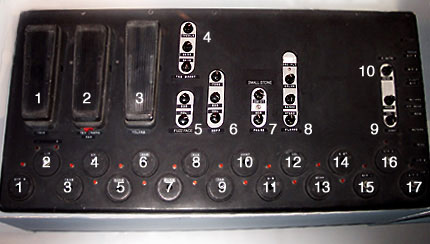Comp Lit, Pt. 1: Mama’s Got A Squeezebox
by John Drenning
A particular tone obsession of mine started with David Gilmour. In fact, I’m pretty certain that at least 80% of tonal tail-chasing among Men Of A Certain Age involves British rock bands of ’65-’75, a period more or less bracketing the Blues Breakers’ Beano album on one end, and “Dark Side Of The Moon” on the other. Or maybe 70%, when you factor in Hendrix being American, even though he had to go to to England to get famous. But as I said, in this case Gilmour’s to blame, in particular his solo on “Time.”
I had an experience a few years back that maybe some of you can relate to: I heard a classic rock warhorse for probably the 6,000th time, a song I thought I knew inside and out – but because I’d been obsessing over gear so much, I heard it with different ears. It felt like I was hearing “Time” for the first time.
What slayed me was that solo. Holy crap! I realized I’d never really listened to it. What killed me about that tone was the fact that it sounded huge – like he had 10 Strats plugged into 10 Big Muffs and 10 Hiwatt full stacks, all on, yes, 10.
But at the same time the tone was so dynamically flat. There’s almost no attack to the notes, and no decay – the opposite of the classic Marshall roar. Seemed like he could play a note, and go out for a bite, Nigel Tufnel-style, and come back and that note would still be hanging in the air, at the same volume as when he first picked it. (And while there are many fine qualities of Strats, massive sustain’s not generally one of them.)
The word I associated with the tone on that solo is one that sounds like it an insult, but is intended as the opposite:
Squashed.
So I went down the internet black hole, and discovered esoteric higher knowledge (who is Pete Cornish? What’s a VGA? Do I want my Knee to be Hard, or Soft?), which led me to – you guessed it – compressors. In particular, the guitarist’s workhorse comp pedal, the venerable MXR M-102 Dyna-Comp.
To Craigslist, and $35 later I was ready to rock – non-dynamically, of course. Maybe I’d even receive that telegram from Roger Waters, telling me that Dave Kilminster was fired, and the great gig in the sky was mine.
Comp 101
The job compressors do is pretty simple. Think of your cringe-inducing voice, captured on a voicemail. Part of why your voice sounds so much less cool entering your head than it does leaving it is because when you’re hearing your voice, you realize how much the volume varies. Some words are too loud, some are too quiet – the whole thing’s a mess. But when you listen to the radio, the DJ sounds perfect. All the words are equally loud, so they’re easy to understand and pleasing to listen to.
Partly this is because they worked really hard on how to talk, but it’s also because behind every successful broadcast personality there’s an engineer, and that engineer’s nicotine-stained fingers are operating a very expensive rack-mounted compressor.”And that compressor is doing the exact same thing a Dyna Comp is: It’s making the quiet parts louder and the loud parts quieter, so that the overall volume is more or less even. The main difference is that the rack mount processor goes about its business much more “transparently,” but we’ll get to that later.
The dynamic transience (those words work!) of a picked note can be a real challenge for an electric guitarist. If you want to sound like Stevie Ray Vaughan (and who doesn’t), then the rise and fall of a note is an expressive tool. A good guitarist will exploit this to give their solos a more vocal quality.
But what if you’re playing clean arpeggios, and some notes are ringing more loudly than others? Or you’re playing a tricky multi-note passage, and some notes crap out on you, making that passage sound uneven? Or you’re quickly strumming a chorded funk progression, but instead of sounding like Nile Rodgers, the unevenness of your pick attack makes the volume of the chords rise and fall? Or you’re trying to wring a little more out of each note in a solo, trying to squeeze a little more grease out of them, preferably with your picking hand held high, raising your Goblet of Rock, but instead the notes fade off into obscurity?
Well, sir or m’am, what you need is a compressor.
You might not think you do, since unlike a distortion box, wah, chorus, etc., you don’t really hear a compressor. A compressor doesn’t especially make your guitar sound different – you don’t hear it like you hear an effect. Instead, a compressor just makes you sound better.
It’s a “cheater” pedal: It can make you sound like a better player than you are, by smoothing out some of the clams in your playing, and give you – as the craigslist posts say – “sustain for days.” So what particular things can a compressor do for you?
Find out tomorrow!
Coming soon:
Tomorrow
Comp Lit, Pt 2: Compressors – more awesome than you think.
Soon
Comp Lit, Pt 3: A review of the brand new Dunlop CSP202 Custom Comp Compressor Pedal.
Comp Lit, Pt 4: The Dunlop Custom Comp goes mano a mano with the Dyna Comp, Keeley and Diamond compressors.
During the day, John Drenning is a mild-mannered professional. But on his off hours he’s a tone fiend.
P.S.
Since everyone doesn’t read every post, will append posts with this for a bit. C’mon fellas!
Doing a “keep the lights on and do more cool sh*t” fund drive. If you dig and look forward to WoodyTone, and find the info fun and valuable, please frickin’ donate! Options for a one-time $20 or $5/mo below. Gracias amigos! Vamonos!
$20 one-time
$5/mo recurring
Category: David Gilmour, MXR
















Comments (1)
Trackback URL | Comments RSS Feed
Sites That Link to this Post